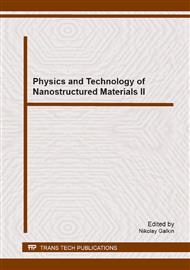[1]
S.A. Dotsenko, D.V. Fomin, K.N. Galkin, D.L. Goroshko, N.G. Galkin. Growth, optical and electrical properties of Ca2Si film grown on Si(111) and Mg2Si/Si(111) substrates, Physics Procedia 11 (2011) 95-98.
DOI: 10.1016/j.phpro.2011.01.015
Google Scholar
[2]
S. Lebegue, B. Arnaud, and A. Alouani, Calculated quasiparticle and optical properties of orthorhombic and cubic Ca2Si, Phys. Rev. B 72 (2005) 085103 (1-8).
Google Scholar
[3]
L. Dózsa, G. Molnár, Z. Zolnai, L. Dobos, B. Pecz, Galkin N.G., S.A. Dotsenko, D.A. Bezbabny, D.V. Fomin, Formation and characterization of semiconductor Ca2Si layers prepared on p-type silicon covered by amorphous silicon cap, J. Mater. Sci. 48 (2013).
DOI: 10.1007/s10853-012-6945-6
Google Scholar
[4]
P. Manfrinetti, M.L. Fornazini and A. Palenzona, The phase diagram of the Ca-Si system, Intermetallics 8 (2000) 223 – 228.
DOI: 10.1016/s0966-9795(99)00112-0
Google Scholar
[5]
S.A. Dotsenko, K.N. Galkin, D.A. Bezbabny, D.L. Goroshko, N.G. Galkin, Formation, optical and electrical properties of a new semiconductor phase of calcium silicide on Si(111), Physics Procedia 23 (2012) 41-44.
DOI: 10.1016/j.phpro.2012.01.011
Google Scholar
[6]
S.A. Dotsenko, N.G. Galkin, L.V. Koval', V.O. Polyarnyi, In situ differential reflectance spectroscopy study of solid phase epitaxy in Si(111)-Fe and Si(111)-Cr systems, e-J. Surf. Sci. & Nanotechn. 4, (2006) 319-329.
DOI: 10.1380/ejssnt.2006.319
Google Scholar
[7]
N.G. Galkin, D.V. Bezbabny, K.N. Galkin, S.A. Dotsenko, I.M. Chernev, A.V. Vakhrushev, Formation, optical and electrical properties of Ca3Si4 films and Si/ Ca3Si4/Si(111) double heterostructures, Chemical Physics and Mesoscopy, 3 (2013).
DOI: 10.1201/b18552-24
Google Scholar
[8]
www. icdd. com.
Google Scholar
[9]
J.I. Pancove, Optical Processes in Semiconductors, Dover, New York, (1971).
Google Scholar
[10]
N.G. Galkin, D.A. Bezbabnyi, K.N. Galkin, S.A. Dotsenko, E. Zielony, R. Kudrawiec and J. Misiewicz, Formation and optical properties of semiconducting thick Ca silicide films and Si/CaxSi/Si heterostructures on Si(111) substrate, Physica Status Solidi, (2013).
DOI: 10.1002/pssc.201300364
Google Scholar
[11]
D.B. Migas, V.L. Shaposhnikov, A.B. Filonov, N.N. Dorzkin, V.E. Borisenko, New semiconducting silicide Ca3Si4, J. Phys. Condens. Matter, 19 (2007) 346207 (1-8).
DOI: 10.1088/0953-8984/19/34/346207
Google Scholar
[12]
V.V. Kveder, E.A. Steiman, S.A. Shevchenko and H.G. Grimmeis, Dislocation related electroluminescence at room temperature in plastically deformed silicon, Phys. Rev. B, 51 (1995) 10520-10528.
DOI: 10.1103/physrevb.51.10520
Google Scholar
[13]
Z. W. Yang, D. Shia, B. Wena, R. Melnikb, S. Yao, T. Lia, First-principle studies of Ca–X (X=Si, Ge, Sn, Pb) intermetallic compounds, J. Solid State Chem., 183 (2010) 136–143.
DOI: 10.1016/j.jssc.2009.11.007
Google Scholar


